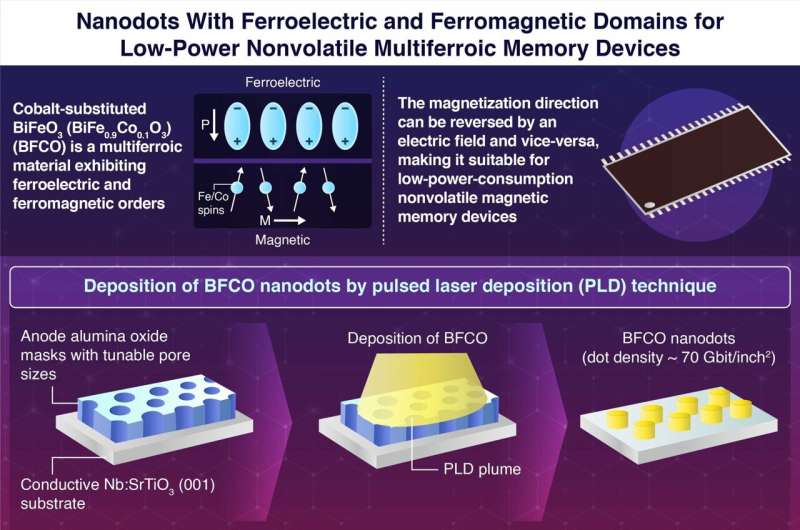BFCO 60 nm nanodots have a single domain structure and are promising for use in high-density and low-power non-volatile magnetic storage devices.Image source: Tokyo Institute of Technology
Traditional storage devices are volatile, while current non-volatile storage devices rely on ferromagnetic or ferroelectric materials to store data. In ferromagnetic components, data is written or stored by aligning magnetic moments, while in ferroelectric components, data storage relies on the alignment of electric dipoles.
However, generating and manipulating magnetic fields is energy intensive, and in ferroelectric storage devices, reading data destroys the polarization state, requiring the storage cells to be rewritten.
Multiferroic materials contain both ferroelectric and ferromagnetic orders, providing a promising solution for more efficient and versatile storage technologies. Cobalt substituted BiFeO3 (BiFe0.9cobalt0.1oxygen3BFCO) is a multiferroic material that exhibits strong magnetoelectric coupling, which means that changes in electrical polarization affect the magnetization.
Therefore, data can be written using an electric field, which is more energy-efficient than generating a magnetic field, and read using a magnetic field, thus avoiding the destructive readout process.
A research team led by Professor Masaki Azuma and Assistant Professor Kei Shigematsu of Tokyo Institute of Technology, Japan, successfully developed nanodots with single ferroelectric and ferromagnetic domains, which is an important milestone in multiferroic memory devices.
“In Sumitomo Chemical’s Collaborative Research Cluster for Next-Generation Environmentally Friendly Devices within the Innovation Research Institute of Tokyo Institute of Technology, the focus is on multiferroic materials, which exhibit mutually correlated responses between magnetic and electrical properties based on the principle of strong magnetism. Related Electronics system.
“The center’s goal is to develop materials and processes for next-generation low-power non-volatile magnetic storage devices and conduct reliability evaluation and social implementation,” Azuma said.
Their research was published in the journal ACS Applied Materials & Interfaces On April 9, 2024, researchers used pulsed laser deposition to deposit multiferroic BFCO onto conductive Nb:SrTiO3 (001)Substrate. They controlled the deposition process by using an anodized aluminum oxide (AAO) mask with tunable pores, resulting in nanodots with diameters of 60 nm and 190 nm.
BFCO is a promising option for low-power, non-volatile magnetic storage devices because its magnetization direction can be reversed by an electric field. The researchers used piezoresponsive stress microscopy and magnetic force microscopy to observe the polarization and magnetization directions, respectively, and found that the nanodots exhibited related ferroelectric and ferromagnetic domain structures.
Interestingly, they noticed significant differences when comparing nanodots of different sizes. Smaller 60 nm nanodots fabricated using oxalic acid AAO masks show single ferroelectric and ferromagnetic domains in which polarization and magnetization directions are always consistent.
However, larger 190 nm nanodots formed using malonate AAO masks possess multidomain vortex ferroelectric and magnetic structures, showing strong magnetoelectric coupling.
“This ferroelectric and ferromagnetic single-domain structure will be an ideal platform to study BFCO as an electric field write and magnetic readout memory device, while the multi-domain structure provides a basis for basic research,” Shigematsu said.
Non-volatile magnetic storage devices are critical to a variety of electronic applications because they retain stored information even when the power is turned off. With their unique composition of a single ferromagnetic and ferroelectric domain, BFCO 60nm nanodots show great potential in creating magnetic storage devices that require minimal power for write and read operations.
More information:
Keita Ozawa et al., Single or vortex ferroelectric and ferromagnetic domain nanodot arrays of magnetoelectric BiFe0.9Co0.1O3, ACS Applied Materials & Interfaces (2024). DOI: 10.1021/acsami.4c01232
Provided by Tokyo Institute of Technology
citation: Enhanced Storage Technology: Multiferroic Nanodots for Low-Power Magnetic Storage (2024, April 26) Retrieved April 26, 2024 https://phys.org/news/2024-04- memory-technology-multiferroic-nanodots-power.html
This document is protected by copyright. No part may be reproduced without written permission except in the interests of fair dealing for private study or research purposes. Content is for reference only.
#Enhanced #storage #technology #multiferroic #nanodots #lowpower #magnetic #storage
Image Source : phys.org
